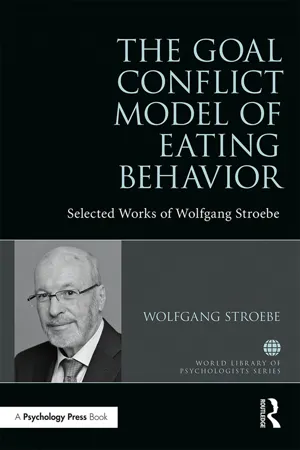
The Goal Conflict Model of Eating Behavior
Selected Works of Wolfgang Stroebe
- 246 pages
- English
- ePUB (mobile friendly)
- Available on iOS & Android
About This Book
In the World Library of Psychologists series, international experts present career-long collections of what they judge to be their finest pieces - extracts from books, key articles, salient research findings, and their major practical theoretical contributions.
In this volume:
Overweight and obesity rates have increased dramatically in most industrialized countries, even though more and more people are chronically dieting. Dieters can manage to lose substantial amounts of weight while actively dieting, but most regain it within a few years. So why do most chronic dieters have such difficulty controlling their weight and why is there only a small minority of successful dieters?
To address these questions, Stroebe developed the goal conflict model of eating behavior, a social cognitive theory that attributes the difficulty of chronic dieters to a conflict between two incompatible goals: eating enjoyment and weight control. Although chronic dieters are motivated to pursue their weight control goal, most fail in food-rich environments: Surrounded by palatable food cues that activate thoughts of eating enjoyment, incompatible weight control thoughts are inhibited and weight control intentions are "forgotten". For successful dieters - probably due to past success in exerting self-control - tasty high-calorie food has become associated with weight control thoughts. For them, exposure to palatable food makes weight control thoughts more accessible, enabling them to control their body weight in food-rich environments.
This book contains the key articles of a research program by Stroebe and collaborators to assess the validity of this theory. They succeeded in tracing the processes that lead from temptation to a breakdown of dieting intentions. They also demonstrated that these theoretical principles can be used to develop effective weight loss interventions. The book should be of value for all researcgers, students and clinicians involved in obesity research and treatment.
Frequently asked questions
Information
Table of contents
- Cover
- Title
- Copyright
- Contents
- Acknowledgments
- List of works reprinted
- PART 1 Introduction
- PART 2 The goal conflict model of eating behavior
- PART 3 Mechanism of dieting success
- PART 4 Developing interventions
- PART 5 Conclusions: putting the pieces together
- Index